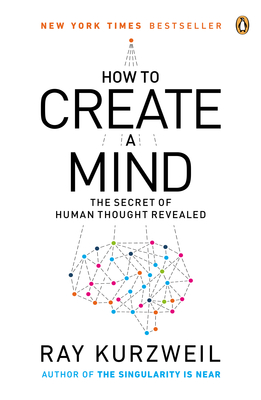How to Create a Mind: The Secret of Human Thought Revealed now available in paperback
August 27, 2013

 Noted futurist Ray Kurzweil unravels the mysteries of human thinking to provide a roadmap to superhuman intelligence in The New York Times best-selling book How to Create a Mind: The Secret of Human Thought Revealed.
Noted futurist Ray Kurzweil unravels the mysteries of human thinking to provide a roadmap to superhuman intelligence in The New York Times best-selling book How to Create a Mind: The Secret of Human Thought Revealed.
Penguin Books, paperback on-sale date August 27, 2013 | ISBN: 978-0-14-312404-7 | $17.00.
The paperback edition is now available at: Penguin Books, Amazon, Barnes & Noble and other booksellers.
“Kurzweil writes boldly and with a showman’s flair, expertly guiding the lay reader into the deep thickets of neuroscience.”
–– The Boston Globe
“It is rare to find a book that offers unique and inspiring content on every page. How to Create a Mind achieves that and more. This is a visionary work that is also accessible and entertaining.”
–– Rafael Reif, President, MIT
No longer science fiction, artificial intelligence has gone mainstream with recent innovations such as IBM’s Watson, the iPhone’s Siri, and Google’s self-driving cars, and research is already underway for the inevitable next step.
In his latest best-selling book, How to Create a Mind, noted futurist and current Director of Engineering at Google Ray Kurzweil examines the groundbreaking research into merging the human brain with the digital cloud, reaching the ultimate level of artificial intelligence.
 Out in paperback this fall, reveals how the mind emerges from the brain and the implications of vastly increasing the powers of our intelligence.
Out in paperback this fall, reveals how the mind emerges from the brain and the implications of vastly increasing the powers of our intelligence.
Kurzweil thoughtfully examines whether or not digital brains can ever replicate a human brain’s emotional and moral intelligence, its consciousness and free will.
Drawing on the most recent neuroscience research, his own research and inventions in artificial intelligence, and compelling thought experiments, Kurzweil reveals how technology can replicate our thinking patterns, and then apply this knowledge to provide a path to superhuman intelligence.
Naysayers argue that the human brain is too complex to be replicated or expanded, and that an artificial brain like Watson’s is just doing statistical analysis as opposed to possessing the “true” understanding of language that humans have.
But Kurzweil counters that if statistical analysis does not constitute true understanding, then the human brain does not understand anything either.
Kurzweil’s “law of accelerating returns” states that information technology, including both the hardware and software of artificial intelligence, is expanding at an exponential rate.
As a result, technology evolution is moving millions of times faster than biological evolution.
This is “inevitably leading to the last invention that humanity needs to make, truly intelligent machines, and the design of one is inspiring the other.”
How to Create a Mind was one of the most widely discussed and debated science books of 2012, taking its place alongside Kurzweil’s previous classics and establishing itself as a touchstone for any consideration of the path of human progress.
For press inquiries: Shannon Twomey | 212.366.2227 | shannon.twomey@us.penguingroup.com
related:
author’s website | How to Create a Mind
